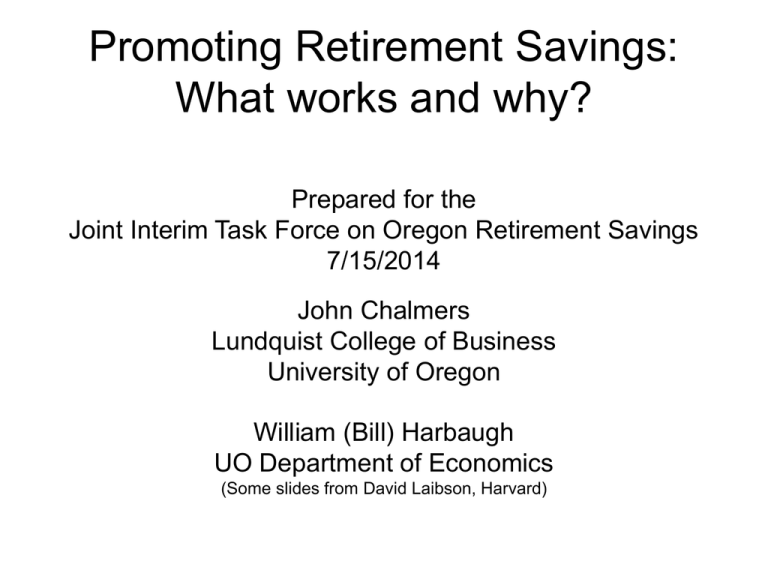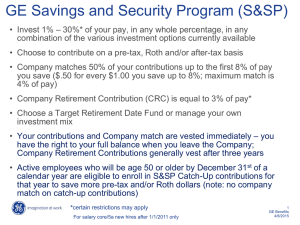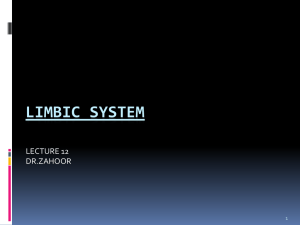Chalmers and Harbaugh`s presentation
advertisement

Promoting Retirement Savings: What works and why? Prepared for the Joint Interim Task Force on Oregon Retirement Savings 7/15/2014 John Chalmers Lundquist College of Business University of Oregon William (Bill) Harbaugh UO Department of Economics (Some slides from David Laibson, Harvard) Life Cycle of Finance Education • Tuition • Student Loans Career Retirement • Repayment of debts • Savings Rate • Investment Choices • When to Retire? • Health Assessment • Annuitizing Balances Compounding Miracles • Save $500/month • Save $500/month • 35 years of contributions • 35 years of contributions • Assume 10% gross returns • Assume 12% gross returns Plan A charges 1.50% Plan A charges 1.50% Plan B charges 0.50% Stock Market Participation Matters • $2.1 vs. $1.2 with a 2% improvement in returns • Default Investments Matters • @10% => $371,948 Minimizing Fees – • @12% => $651,799 1% matters Plan B charges 0.50% Priorities during Career • Make savings happen • Defaults with opt out provisions • Matching plans • Education • Advice • Invest savings well • Stock market participation • Option A • Low fee diversified portfolios • Select to fit risk tolerance • Option B • Well designed default with opt out provisions • Low fee target date fund • Others • Financial education • Financial advisors Education is a tough row to hoe Financial Literacy evidence Lusardi and Mitchell 2006 (HRS 2004) – Ask these questions • Q1 (Compound Interest) : Suppose you had $100 in a savings account and the interest rate was 2% per year. After 5 years, how much do you think you would have in the account if you left the money to grow: more than $102, exactly $102, less than $102? • Q2 (Inflation) :Imagine that the interest rate on your savings account was 1% per year and inflation was 2% per year. After 1 year, would you be able to buy more than, exactly the same as, or less than today with the money in this account? • Q3 (Stock Risk): Do you think that the following statement is true or false? “Buying a single company stock usually provides a safer return than a stock mutual fund.” Get the following Results Literacy in the Oregon University System Good news: • Over 90% of a sample of Oregon University Employees Answer the Literacy Questions Correctly Chalmers and Reuter (2014) Bad news: • Even though they answer the literacy questions correctly – OUS employees make many of the same mistakes in choosing their investments Defaults Improve Savings • Beshears, Choi, Laibson, and Madrian (2008) Financial education/advice? • Education can help but it takes a lot of effort and follow up to prove marginally effective. • Financial advisors – e.g. Bergstresser, Chalmers, Tufano (2009) and Chalmers and Reuter (2013), • Advisors do some good – for example fewer investors in a bad default investment (like Money Market), more international diversification • Incentives matter and advisors respond to those incentives– • Actively managed mutual funds charge investors more and usually pay advisors more than an index fund would pay to their advisors • Little evidence that advisors pick better performing mutual fund investments for their clients • Little evidence that advisor clients recover any of the fees paid to their advisors in better investment performance • Evidence in Chalmers Reuter (2013) that a well specified target date fund would have outperformed advised and do-it-yourself investors in the OUS over an extended sample period. Absent Advice What Happens? • Chalmers and Reuter (2013) find that users of advice are younger, less educated, have lower salaries (Less experienced/less education), and are more likely to choose advisors. • In the OUS, the advice channel was removed from the set of possibilities for new employees in the early 2000s. • We found that those that we would have predicted to choose advisors (less experienced/less education) were more likely to take the default investment after the change • Good news for policy – as long as the plan administrator chooses a default investment that makes sense! • A money market fund would be a poor default • A low fee, well-diversified target date fund would be a good choice Decades of Financial Economics Research Leads to Simple Advice • Be a disciplined saver -- start young • Invest what you are comfortable with in risky investments (e.g. the stock market) • Keep your fees low – don’t chase past performance or the latest tip – buy low fee index funds • Be well diversified – across assets and around the world • It is a puzzle for (behavioral) economists that we have a really hard time getting people to follow this straightforward advice—even family, friends, colleagues, airplane seatmates. • There’s hope with defaults – both savings rates and investment choices! Behavioral economics and saving Tension between stable consumption over lifespan, versus enjoying life now. Old neoclassical economic models treated retirement savings as a rational choice, people carefully planned to balance these two objectives. Increasing savings requires increasing incentives (401K matching) or forced savings (Social Security). New behavioral economic models are based on the idea that retirement savings decisions also include plenty of emotion, confusion, ignorance, and systematically irrational behaviors. If true, this means more justification for government involvement, and a much wider set of potentially effective policies to increase savings. Time inconsistent decisions The evidence for “irrational” behavior started with surveys and economic experiments People would say they planned to start saving for retirement “next year”. Next year would roll around, and they'd still want to start saving “next year”. These are time-inconsistent, irrational decisions. Almost like a struggle between your current and your future self. Neuro-economic methods now allow us to see what's happening inside people's brains as people make these choices. Neuroeconomics: We use an MRI scanner, tuned to pick up signals from oxygenated blood in the brain. Thinking is just networks of neurons, firing electrically. The energy comes from blood oxygen delivered by capillaries to the part of the brain where the neuron firing is occurring. So “functional MRI” can give us a 3D image of brain activity, over time, as people think and make economic decisions in an experiment. The brain isn't a well designed computer. As we evolved, the more primitive parts weren't replaced. Instead they were adapted to make the new choices humans faced, with control from the human “neo-cortex”. •Limbic system •vs. Fronto-Parietal System •Frontal •cortex •Parietal •cortex •Limbic •system Savings choices in the brain scanner (McClure et al. 2004, Science) Two decisions: 1) Immediate choice: $20 now, or $30 next month? 2) Delayed choice: $20 next month, or $30 in two months? People generally answer: 1) Take $10 now. 2) Wait to get $20 in two months. And they use two different brain networks when thinking about immediate choices and delayed choices. The primitive, emotional, limbic system for immediate choices, and the more evolved frontal-parietal system for delayed choices Emotional brain 7 A T13 0 x = -4mm B VStr d = Today y = 8mm MOFC d = 2 weeks z = -4mm PCC MPFC d = 1 month 0.2% 2s Analytic brain A B VCtx PMA RPar DLPFC VLPFC LOFC x = 44mm 0.4% 2s x = 0mm 0 T13 15 d = Today d = 2 weeks d = 1 month Brain Activity in the Frontal System and Limbic System Predict Savings Behavior (Data for choices with an immediate option.) Frontal system Brain Activity 0.05 0.0 Limbic System -0.05 Choose Immediate Reward Choose Delayed Reward Implications Two competing neural systems fight each other. Emotional brain wants to consume now, the frontal cortex is willing to save. We can give the frontal cortex a helping hand by the way we structure the decisions: - Make the default option to save, so the limbic system has a higher hurdle to overcome. - Start with small savings, increase them automatically. People aren't sacrificing when they make the decision, tricks the limbic system. - Make decisions simple. Confusion overwhelms the frontal cortex, depletes its ability to exercise control, and helps the limbic system. - Make people commit. The limbic system is just waiting for its chance to spend the money now, e.g credit cards. Other relevant behavioral economics: • Status quo bias and default effects. • Loss aversion and risk seeking in investment decisions after losses. • Ambiguity aversion. • Paradox of choice. • Gender differences in risk preferences, financial literacy, confidence and overconfidence. Abbreviated references: • Bergstresser, Daniel, John M.R. Chalmers, and Peter Tufano, 2009, Assessing the Costs and Benefits of Brokers in the Mutual Fund Industry, The Review of Financial Studies, 22, 10, 4129-4156. • Beshears, Choi, Laibson, Madrian, 2008, The Importance of Default Options for Retirement Saving Outcomes: Evidence from the United States.” In Lessons from Pension Reform in the Americas, Stephen J. Kay and Tapen Sinha, editors. • Chalmers, John and Jonathan Reuter, 2012, How Do Retirees Value Life Annuities? Evidence from Public Employees, The Review of Financial Studies, 25, 8, 2601-2634. Winner of the TIAA-CREF 2013 Paul A. Samuelson Award for Outstanding Scholarly Writing on Lifelong Financial Security. • Chalmers and Reuter, 2013, What is the impact of financial advisors on retirement portfolio choices and outcomes?, working paper. • Choi, Laibson, Madrian, and Metrick, 2006, “Savings for Retirement on the Path of Least Resistance,” In Behavioral Public Finance: Toward a New Agenda, Ed MacCaffrey and Joel Slemrod, editors. • Lusardi and Mitchell. 2005. Financial literacy and planning: Implications for retirement wellbeing. Working Paper No. WP 2005-108. Ann Arbor, MI: University of Michigan Retirement Research Center. Available at http://www.mrrc.isr.umich.edu/publications/papers/pdf/wp108.pdf • Madrian and Shea. 2001. The power of suggestion: Inertia in 401(k) participation and savings behavior. Quarterly Journal of Economics











